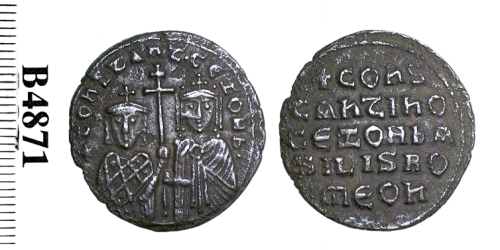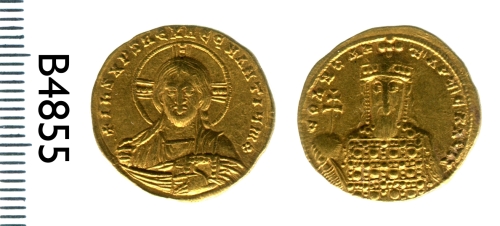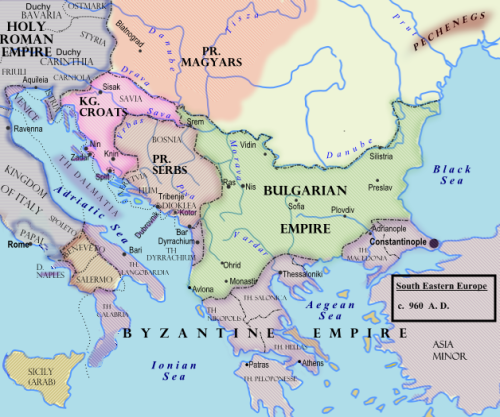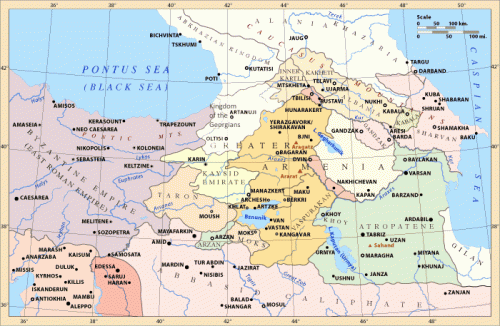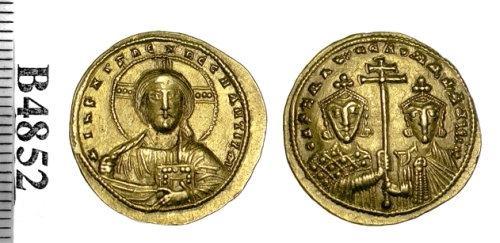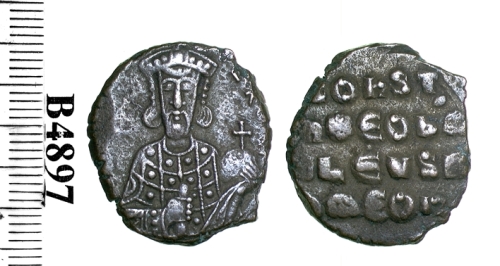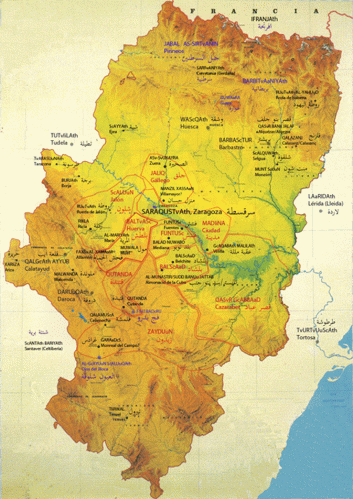A weekend full of reading lists and finishing small things didn’t leave time for blog, but this week I am back on it with the third part of the report from last year’s International Medieval Congress at Leeds. A great deal of this day was connected with the retirement of Professor Ian Wood, the same circumstance which led me to be taking up a post in his absence next year, which left me feeling simultaneously as if it would be tactless of me to be at those sessions and as if it would be rude of me not to. In the end, therefore, I let reverence of the greats and relevance to my interests guide me, and so the day began like this.
1014. The Merovingian Kingdoms: sessions in honour of Ian N. Wood, I
- Yitzhak Hen, “Introduction”
- Danuta Shanzer, “Avitus of Vienne: onwards and upwards”
- Régine Le Jan, “Merovingian Elite in the 7th Century: competitive and cooperative logics”
- Paul Fouracre, “Town and Country in Merovingian and Early Carolingian Hagiography”
- Yitzhak Hen, “Response”

Beginning of a text of the so-called Law of Gundobad, from Wolfenbüttel, Herzog August Bibliothek, Cod. Guelf. 130 Blank, fo. 150r
After this, whether from embarrassment or not I don’t know, I reverted to my numismatic background for a session.
1143. Conceptualizing Value in Early Medieval Europe
- Dagfinn Skre, “To Value and To Trade: two sides of the same coin”
- Alessia Rovelli, “La monnaie comme mesure de la valeur et moyen d’échange dans l’Italie du haut moyen âge”, with “Summary” by Chris Wickham
- Rory Naismith, “Pecuniary Profanities? Money, Ritual, and Value in the Early Middle Ages”
This was probably something I had to go to anyway, wasn’t it? The value systems that support early medieval coinage are increasingly something I worry about, since it is used so differently to modern money that assumptions are too easily transported. Here were three other people worrying about it too. There is a sort of orthodoxy that money came into being as a means to make trade easier; Dr Skre had lately met the work of David Graeber that questions this and suggests that pre-monetary societies work differently, with exchange structured by obligations, not by value; as soon as you have value as an independent concept, as a quantity that can be owed, a line has been crossed that the introduction of money doesn’t alter.5 I’ve been agnostic about this so far but Dr Skre’s looking at the earliest Norwegian lawcodes for compensation tariffs, measured in coin-terms but obviously untradeable (since you can’t pass on someone’s eye, etc.) had me readier to believe it than I had been before. Dr Rovelli looked at late-eighth-century Italy, where a system based on Lombard gold was rapidly (as far as documents mentioning the things indicate) replaced by a system based on Carolingian silver but where, as she explained, finds of Carolingian coinage are really very rare compared to silver of other periods. Of the finds that there are, only Milan’s and Venice’s coinages seem to have travelled very far but even then there’s not much.6 As Chris Wickham put it in summary, this makes it seem like the Carolingian denier was much more a unit of account than anything people actually used. Rory then followed this up by looking at the question of hoards of coins used as ritual deposits, not just in pagan contexts but specifically as Christian alms in the context of the Forum Hoard which he and others have been investigating.7 Obviously these are not a priori economic uses, and Rory matched this with XRF analysis of the contemporary papal silver, whose content is pretty unvarying and often higher than its contemporaries. There’s no sign that stuff given to the Holy See was being melted down to make more coin, therefore, the spheres were kept separate. I have my reservations about XRF for trace elements even when done really well, to which we’ll return in a few posts’ time, but this had been done well and by this time what Rory was suggesting seemed to make sense anyway.

Silver denaro of Pope Benedict IV with Emperor Louis the Blind, struck in Rome between 901 and 903, NAC Numismatica SpA auction, 18 December 2010, a very special coin not just because of the price it made but because it is also an early medieval rebus. Can anyone see it?
There was lots of discussion in this session. To my delight this included an orthodox Marxist (Señor de Carvalho Pachá of the previous day) insisting that value was capitalist and that Marx himself showed that Graeber is wrong, to which Dr Skre replied that in his materials value was created by comparison, not production, and when you’re dealing with compensation for offences against the person, that is a strong position I think. I suggested that precious-metal coin was all too high-value for us to talk about monetisation in any market sense anyway and that it must have all been ‘special’ in some way, to which Dr Skre again reasonably replied that coin is a lot lower-value than the masses of bullion people in his research area sometimes stashed or transacted. Morn Capper argued with Rory about whether the Forum Hoard could really be part of the English annual donation to the Holy See known as Peter’s Pence, since there isn’t that much of it from that point of view, and I don’t think this got settled. I then wound up arguing privately with Morn about the use of bronze coin; as she said, it does sometimes happen in Northern Europe, such as eighth-century Northumbria, but as I said it also happens anywhere Byzantine but, importantly, that doesn’t lead to the non-Byzantine areas in contact with those ones seeing low-value coin as solving a trade problem they’ve always had and adopting it straight away. The utility argument for money actually falls over badly when you place it in the early Middle Ages. This is one of the reasons I now contend for the value of the study of this period; it often breaks other people’s general theories quite badly!
So that was all really useful and left me with much to discuss with people over lunch, but for the rest of the day I was called back to the Rupert Beckett Lecture Theatre and the lauding and magnification of Ian Wood. The first of these sessions combined several loyalties, though, and I might have had to go anyway.
1214. Material Culture and Early Medieval History: sessions in honour of Ian N. Wood, III
- Leslie Brubaker, “The Earliest Images of the Virgin Mary, East and West”
- Helmut Reimitz, “Between Past and Future: Roman History in the Merovingian Kingdoms”
- Richard Morris, “Landscape, Archaeology and the Coming of Christianity to Northern England”
- Alan Thacker, “Response”
Leslie, at this point still in my chain of command, detected a difference between the way that the Virgin Mary was depicted in the early Christian world between Rome, where the popes were her biggest champions and between the fifth and eighth centuries settled into depicting her as the Queen of Heaven, in full golden royal attire. Perhaps naturally, in the East the emperors did not do this; Mary appeared enthroned with the Son, yes, but the royal attire stayed firmly on the imperial patrons. Helmut’s paper, despite his title, was more about the use of Roman law in the Merovingian kingdoms, focusing especially on the trial of Bishop Praetextatus by King Chilperic, because Chilperic condemned him according to the canon law of the Roman Church.8 Admittedly, Gregory of Tours claims that the king had added these laws to the canons himself, but the relevant law is in eleven manuscripts of the Theodosian Code and copied into five of the Breviary of Alaric and one of the Salic Law. The Roman past was still in use here, but not always by its self-appointed custodians. Richard Morris, picking up on another strand of Professor Wood’s work, looked at a group of Northumbrian monasteries of which several are only known through archæology, arguing that they were usually on previously-sacred sites but also represent a fair degree of royal initiative to establish Christianity so widely across a landscape so fast.9 The identity of the founders seems to me hard to demonstrate from archæology alone and the group didn’t seem to me to be too unified on a map, but the pagan precursors were well demonstrated. Lastly Alan drew the papers together with the thread of the Empire, one of the papal Marian churches being an imperial foundation in origin and these churches being the inspiration for at least some of the Northumbrian foundations like the (non-royal) Wearmouth-Jarrow. This session also achieved its purpose to an extent in that it provoked Professor Wood to draw further links between the papers, because as Alan had said, his work had enabled the spread of the session and its range of comparison in the first place.
Then tea and back to the theatre once more for the papers in this group which, for me at least, had promised the most fun of all.
1314. The Transformation of the Roman World: sessions in honour of Ian N. Wood, IV
- Ralph Mathisen, “Pacu and his Brother: a Romano-Alamannic family from post-Roman Heidelberg”
- Chris Wickham, “Information Exchange on the Papal Estates of Sicily, c. 600″
- Ann Christys, “Was Spain Different in the Eighth Century?”
- Stuart Airlie, “Response”

Detail from a replica of the seventh-century Alemannic scabbard from Gutenstein, not showing a great deal of Roman influence but of course also rather later than we’re talking about. Photo by Schristian Bickel – Eigenes Werk, CC BY-SA 2.0 de, https://commons.wikimedia.org/w/index.php?curid=3078209
Professor Mathisen focused on a single monument from the Agri Decumates, an area supposedly utterly lost to Roman control thanks to the Alemans in the third-century crisis; the names on the monument seem to show an Aleman with Roman children and invokes Roman gods but does so in a way that no other monument Professor Mathisen knew does, with a double field across which the text runs in continuous lines. I remember this and it looks weird—sadly I can’t find an image [Edit: but Mark H. can, as witness his comment, thankyou!]—but it’s obviously not a rejection of Rome, and there are apparently plenty of other signs of continuity in this area once one accepts that as possible. Conquest obviously wasn’t simple here. Chris then looked at the letters of Pope Gregory I, and I will probably remember nothing from this conference as warmly as his five-minute précis of the kinds of things Gregory was writing to his distant estate managers on Sicily about (“Give me back the onyx vase I lent you”), but the point was the level of micro-management Gregory was attempting by letter, chasing up cases and missed payments, making appointments, policing rent levels and answering pleas from his people against his own officials. It seems difficult to believe that this could have worked, given his removal from actual events, but he obviously thought it could, and this should perhaps make us think about other people whose letters didn’t happen to be preserved because of being pope.10 Ann Christys then reminded us of the awkwardly large gap we have between the conquest of al-Andalus by Muslim forces in 711 and the first texts that talk about it, from the ninth and tenth centuries; the archæology doesn’t show very much break until then either, but the texts are very uninterested in the Spanish past except as it had led to their conquest, even though it was still the environment in which their co-religionists and even they lived.11 Stuart Airlie, in closing, firstly wished that Bede could have done the response instead of him, secondly wondered why we even still try to divide the medieval from the ancient worlds and thirdly pointed out quite how many different agents we have to envisage in the transformation of the session’s title, working perhaps not as disconnectedly as is often imagined but all in their own local contexts and to purposes that cannot have been very much aligned. Whether the detail can ever be resynthesized is an open question but he encouraged everybody to keep working on it anyway. In discussion, it was Chris’s paper that drew the most questions, not least Professor Wood sagely pointing out that for some reason Gregory doesn’t try to manage his estates in Provence the same way, and Chris pointing out to someone else I didn’t know that tax can’t have been be the supporting infrastructure because it wasn’t to Rome that tax went any more. There was certainly a lot to think about now that we had been presented with a mechanic of governance in such detail.
Now, this was the night of the dance, but as is sadly becoming a tradition I didn’t go; I don’t like the Students Union’s club space in which it is held, or the drink they are willing to supply to help you endure it. I hope I’m not just too old now. I think I reverted instead to an ancient Leeds tradition of drinking beer in the bar with every intent of going along to the dance ‘to look’ until it was late enough that it made no sense to do so. After all, the next day was show-time, as I will report in a couple of posts’ time.
1. The text is his Adversus legem Gundobadi, printed in L. van Acker (ed.), Agobardi Lugdunensis opera omnia Corpus Christianorum Continuatio mediaevalis 52 (Leuven 1981), pp. 19-28 (no. 2). As far as I know there’s no translation yet.
2. Here the text is the Vita Eligii episcopi Noviomagensis, ed. by Wilhelm Levison in Bruno Krusch (ed.), Passiones vitaeque sanctorum aevi Merovingici (II), Monumenta Germaniae Historica (Scriptores rerum merovingicarum) IV (Hannover 1902), pp. 663-742, transl. JoAnn McNamara in Paul Halsall (ed.), Internet Medieval Sourcebook, http://sourcebooks.fordham.edu/basis/eligius.asp, last modified October 1998 as of 1 September 2016.
3. Paul’s examples were the Passio Praeecti, well-known to him of course and full of buildings, the Lives of the Jura Fathers, with the landscape out to get the exiles, Jonas’s Vita Columbani, where the rustics are the saint’s biggest fans, and the Vita Sturmi, Vita Galli and Gesta Abbati Sancti Wandregisili for clearance and colonisation. You can find these respectively as Bruno Krusch (ed.), “Passio Praeiecti episcopi et martyris Arverni”, in Krusch & Wilhelm Levison (edd.), Passiones vitaeque sanctorum aevi Merovingici (III), Monumenta Germaniae Historica (Scriptores rerum merovingicarum) V (Hannover 1910), pp. 225-248, transl. in Paul Fouracre & Richad Gerberding (transl.), Late Merovingian France: history and hagiography 640-720 (Manchester 1996), pp. 254-300; François Martine (ed./transl.), Vita patrum jurensium : Vie des Pères du Jura. Introduction, texte critique, lexique, traduction et notes, Sources chrétiennes 142 (Paris 1968), English in Tim Vivian, Kim Vivian, Jeffrey Burton Russell and Charles Cummings (edd./transl.), The Lives of the Jura Fathers: The Life and Rule of the Holy Fathers Romanus, Lupicinus, and Eugendus, Abbots of the Monasteries in the Jura Mountains, with appendices, Avitus of Vienne, Letter XVIII to Viventiolus, and Eucherius of Lyon, The Passion of the Martyrs of Agaune, Saint Maurice and His Companions, and In Praise of the Desert, Cistercian Studies 178 (Kalamazoo 1999) or as Vivian, Vivian & Russell (transl.), Lives of the Jura Fathers (Collegeville MN 2000); Krusch (ed.), “Vitae Columbani abbatus et discipulorumque eius libri duo auctore Iona” in idem (ed.), Passiones vitaeque sanctorum aevi Merovingici (I), Monumenta Germaniae Historica (Scriptores rerum merovingicarum) III (Hannover 1902), pp. 1-156 at pp. 64-108, English in Dana C. Munro (transl.). “Life of St Columban, by the Monk Jonas” in Translations and Reprints from the Original Sources of European History Vol. II no. 7 (Philadelphia PA 1895); Eigil, Vita Sancti Sturmi, in Goegr Heinrich Pertz (ed.), Monumenta Germaniae Historica (Scriptores in folio) II (Hannover 1829), pp. 365-377, transl. C. H. Talbot in idem, The Anglo-Saxon Missionaries in Germany (London 1954), pp. 181-204, repr. in Thomas F. X. Noble and Thomas Head (edd.), Soldiers of Christ: saints and saints’ lives from late Antiquity and the early Middle Ages (University Park 1995), pp. 165-188; Maud Joynt (ed./transl.), The Life of St Gall (Burnham-on-Sea 1927); and F. Lohier & Jean Laporte (edd.), Gesta sanctorum patrum Fontanellensis coenobii (Rouen 1931), as far as I know no English version.
4. On which see for example Marie-Thérèse Flanagan, “The contribution of Irish missionaries and scholars to medieval Christianity” in Brendan Bradshaw and Dáire Keogh (edd.), Christianity in Ireland: revisiting the story (Blackrock 2002), pp. 30-43 (non vidi).
5. The book of Graeber’s I was told to read, long ago, is his Toward an Anthropological Theory of Value: The False Coin of Our Own Dreams (New York City 2001), but it seems that his Debt: the first 5000 years (Brooklyn NY 2011) is now the go-to. On this exact subject, though, compare William Ian Miller, Eye for an Eye (Cambridge 2005), pp. 160-179.
6. This kind of detail of circulation can be got from Clemens Maria Haertle, Karolingische Münzfunde aus dem 9. Jahrhundert (Wien 1997), 2 vols.
7. See already R. Naismith, “Peter’s Pence and Before: Numismatic Links between Anglo-Saxon England and Rome” in Francesca Tinti (ed.), England and Rome in the early Middle Ages: pilgrimage, art, and politics (Turnhout 2014), pp. 217-254.
8. Described in Gregory of Tours, The History of the Franks, transl. Lewis Thorpe (Harmondsworth 1968), V.18; I’m sure you can find the Latin yourselves if you are such as need it.
9. Cited, and for good reason, was Ian N. Wood, “Monasteries and the Geography Of Power in the Age of Bede” in Northern History 45 (2008), pp. 11-26.
10. The letters are translated in John Martyn (transl.), The Letters of Gregory the Great, translated with an introduction and notes (Toronto 2004), 2 vols. There’re lots!
11. See now Nicola Clarke, The Muslim Conquest of Iberia: Medieval Arabic Narratives (Abingdon: Routledge 2012).







